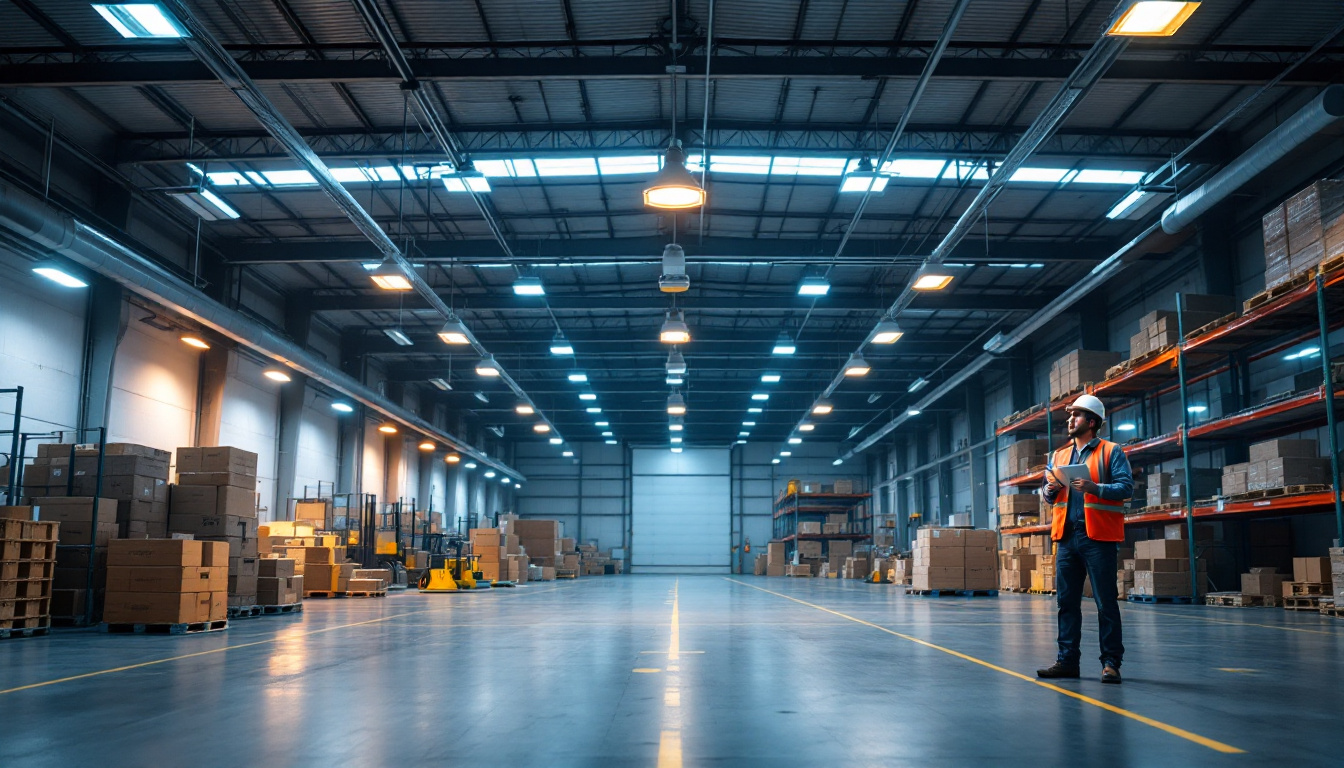

In the realm of commercial spaces, warehouses stand out due to their unique lighting needs. Proper lighting not only enhances safety and productivity but also contributes to energy efficiency and operational costs. For lighting contractors, understanding the best practices in warehouse lighting is essential to delivering optimal solutions to clients. This article delves into the best practices that lighting contractors should adopt when working on commercial warehouse projects.
Before diving into the specifics of lighting solutions, it is crucial to understand the unique characteristics and requirements of warehouse spaces. Warehouses typically have high ceilings, expansive floor areas, and various storage configurations, which all influence lighting design.
Each warehouse is different, and a thorough assessment of the space is the first step in determining the appropriate lighting solution. Factors such as the height of the ceiling, the layout of the storage racks, and the types of activities conducted within the warehouse all play a significant role in lighting design.
Additionally, understanding the types of materials stored and the operational processes can guide the selection of lighting fixtures. For instance, areas involving heavy machinery may require brighter and more durable lighting solutions to ensure safety and efficiency. Furthermore, the presence of windows or skylights can also affect the natural light available, which should be taken into account when planning artificial lighting. Utilizing daylighting strategies can enhance energy efficiency and create a more pleasant working environment, reducing reliance on artificial sources during daylight hours.
Lighting requirements in warehouses can vary significantly based on the tasks performed. For example, areas designated for picking and packing may need higher illumination levels compared to storage zones. It is essential to adhere to industry standards and guidelines, such as those set by the Illuminating Engineering Society (IES), to determine the appropriate lumen levels for different areas.
Moreover, considering the color rendering index (CRI) of the lighting is vital. A higher CRI can improve visibility and accuracy in tasks that involve color differentiation, which is particularly important in environments where inventory management is critical. In addition, the use of motion sensors and smart lighting systems can optimize energy consumption by ensuring that lights are only activated when needed, further enhancing operational efficiency. These systems can be programmed to adjust brightness levels based on the time of day or the presence of personnel, creating a dynamic lighting environment that adapts to the warehouse’s changing needs.
Once the specific needs of the warehouse are understood, the next step is to choose the right lighting solutions. Several options are available, each with its advantages and disadvantages.
LED lighting has become the go-to choice for warehouse lighting due to its energy efficiency, longevity, and low maintenance costs. Unlike traditional lighting options, LEDs consume significantly less energy, which can lead to substantial savings on electricity bills over time.
Moreover, LEDs have a longer lifespan, often exceeding 50,000 hours, which reduces the frequency of replacements. This is particularly beneficial in high-ceiling warehouses where changing bulbs can be costly and time-consuming. Furthermore, LED technology allows for better control over lighting, including dimming capabilities and smart lighting systems that can adapt to the warehouse’s operational needs. This adaptability not only enhances energy savings but also contributes to a more comfortable working environment, as employees can benefit from optimal lighting conditions tailored to specific tasks.
When selecting fixtures, it is essential to consider the height of the warehouse ceiling. High-bay fixtures are ideal for ceilings above 20 feet, providing bright, focused light that can illuminate large areas effectively. In contrast, low-bay fixtures are suitable for ceilings between 12 and 20 feet, offering a more diffused light that is beneficial for lower storage areas.
Choosing the right fixture type can significantly impact the overall lighting quality and energy efficiency of the warehouse. Additionally, incorporating adjustable fixtures can enhance flexibility, allowing for changes in layout or operations without the need for complete reinstallation. This is particularly important in dynamic warehouse environments where inventory and operational needs can shift frequently. By utilizing fixtures that can be repositioned or adjusted, warehouses can maintain optimal lighting conditions, ensuring safety and productivity are always prioritized.
In addition to artificial lighting solutions, integrating natural light into warehouse design can further enhance the working environment. Skylights and large windows can reduce reliance on electric lighting during daylight hours, providing a more pleasant atmosphere for employees. Natural light has been shown to improve mood and productivity, making it a valuable addition to any warehouse.
However, careful planning is required to ensure that natural light does not create excessive glare or uneven lighting conditions. Utilizing light-diffusing materials or strategically placing windows can help mitigate these issues while maximizing the benefits of sunlight. Furthermore, combining natural and artificial lighting can lead to a more sustainable approach, reducing energy consumption and contributing to a greener operation overall.
As technology continues to evolve, so do the possibilities for lighting solutions in commercial warehouses. Smart lighting systems offer numerous advantages, including enhanced control, energy savings, and improved operational efficiency.
Integrating lighting systems with existing building management systems (BMS) can streamline operations and provide valuable data insights. By connecting lighting to a BMS, contractors can enable centralized control, allowing for adjustments based on occupancy, time of day, or specific operational needs.
This integration can lead to significant energy savings, as lights can be programmed to turn off or dim in unoccupied areas. Additionally, real-time data can be collected to analyze lighting usage patterns, helping to optimize energy consumption further. For instance, data analytics can reveal peak usage times, allowing for more informed decisions on lighting schedules and maintenance needs, ultimately extending the lifespan of the lighting fixtures.
Incorporating motion sensors in warehouse lighting can enhance energy efficiency by ensuring that lights are only on when needed. This is particularly effective in areas with sporadic foot traffic, such as storage zones or loading docks. Sensors can detect movement and automatically adjust lighting levels, reducing wasted energy. Moreover, advanced sensors can differentiate between types of movement, such as human activity versus machinery, allowing for tailored lighting responses that enhance safety and productivity.
Daylight harvesting is another innovative approach to warehouse lighting. By utilizing natural light through skylights or windows, contractors can reduce reliance on artificial lighting during daylight hours. This not only conserves energy but also creates a more pleasant working environment for employees. Furthermore, integrating smart glass technology can optimize the amount of natural light entering the space while minimizing glare and heat gain, thus maintaining a comfortable temperature and reducing the need for air conditioning. The combination of these strategies not only promotes sustainability but also contributes to a healthier workplace, which can lead to increased employee satisfaction and productivity.
Safety is paramount in any warehouse setting, and lighting plays a crucial role in maintaining a safe working environment. Properly designed lighting can help prevent accidents and injuries, ensuring compliance with safety regulations.
In addition to regular warehouse lighting, emergency and exit lighting must be considered. These systems are essential for guiding employees to safety in case of power outages or emergencies. Contractors should ensure that these lights are strategically placed and adequately illuminated to be effective.
Regular testing and maintenance of emergency lighting systems are also critical to ensure they function correctly when needed. Compliance with local regulations regarding emergency lighting is essential to avoid penalties and ensure employee safety.
Proper lighting can significantly enhance visibility in high-traffic areas, reducing the risk of accidents. Bright, well-distributed lighting can help employees navigate the warehouse safely, particularly in areas where heavy machinery is in use.
Additionally, it is essential to consider glare and shadows, as these can create hazardous conditions. Using fixtures with appropriate optics and positioning can help minimize glare and ensure that all areas are evenly lit.
Once the lighting system is installed, ongoing maintenance is crucial to ensure optimal performance and longevity. Regular inspections and cleaning can prevent issues that may arise from dust accumulation or fixture degradation.
Implementing a routine inspection schedule can help identify potential problems before they escalate. Checking for burnt-out bulbs, flickering lights, or any signs of damage can ensure that the lighting system operates efficiently and safely.
Additionally, documenting maintenance activities can provide valuable insights into the system’s performance and help in future decision-making regarding upgrades or replacements.
As technology advances, upgrading lighting systems can lead to improved efficiency and performance. Contractors should stay informed about the latest lighting technologies and trends to provide clients with the best possible solutions.
Upgrading to newer, more efficient fixtures or integrating advanced control systems can enhance energy savings and improve the overall lighting quality in the warehouse. Regularly reviewing the lighting system’s performance can help identify when upgrades are necessary.
Effective warehouse lighting is a multifaceted endeavor that requires careful planning, implementation, and maintenance. By understanding the unique needs of warehouse spaces and adopting best practices, lighting contractors can deliver solutions that enhance safety, efficiency, and productivity.
From selecting the right fixtures to integrating smart technologies and ensuring compliance with safety regulations, each aspect plays a critical role in the overall success of a warehouse lighting project. By prioritizing these best practices, contractors can not only meet but exceed client expectations, paving the way for a brighter, more efficient future in commercial warehouse lighting.
Ready to elevate your commercial warehouse lighting projects? At LumenWholesale, we provide lighting contractors with the highest quality, spec-grade lighting products at prices that can’t be beaten. Say goodbye to local distributor markups and hello to our extensive selection that meets rigorous industry standards. With free shipping on bulk orders, you can trust that you’re getting premium lighting at the best value — without any hidden fees. Make your next project shine with the perfect blend of quality, affordability, and convenience. Wholesale Lighting at the Best Value is just a click away.

Discover the essential insights lighting contractors need to master pendant lighting installations.

Discover essential insights and expert tips for lighting contractors on hanging lights effectively.

Discover the essential insights lighting contractors need to know about flush mount ceiling lights.

Discover the essential insights every lighting contractor needs to know about solar lighting.
Get notified when NEW deals are released.
Optimize your budget with wholesale discounts.
Only top-quality, specification-grade lighting products.
No additional costs at checkout - what you see is what you pay.
We understand the unique needs of contractors.